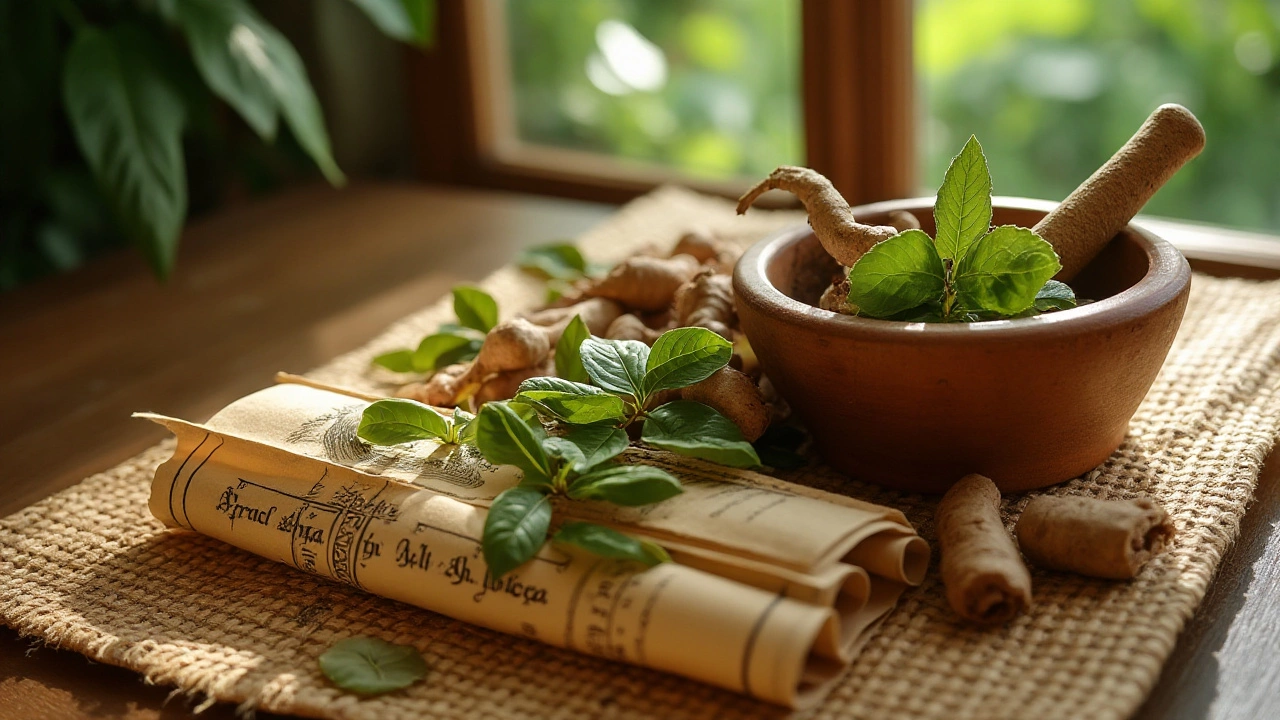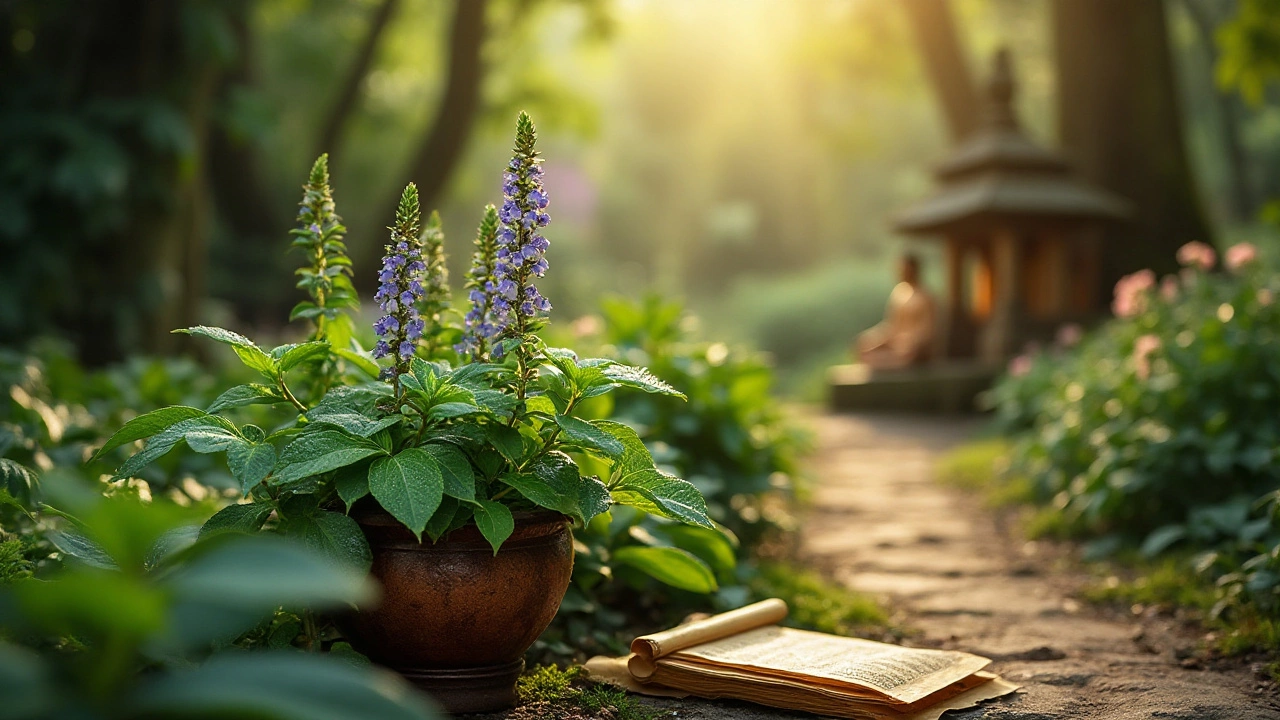Ayurveda, the ancient Indian system of medicine, treasures a multitude of herbs for their healing prowess. Among these, one herb reigns supreme as the 'king', celebrated for its exceptional health benefits and versatility. Recognizing this herb's unmatched status requires a journey back through thousands of years of history, tradition, and enduring practice.
This plant's healing attributes aren't merely tales from antiquity; scientific studies today continue to unravel its complex compounds and their profound effects on human health. From immune support to mental clarity, the benefits are wide-ranging and impactful.
Our modern world offers numerous ways to harness the power of this iconic herb, whether through traditional remedies or contemporary innovations. Understanding how to best incorporate this herb into everyday life is essential for maximizing its benefits, making ancient wisdom work in harmony with modern living.
Historical Significance
In the tapestry of Ayurveda, the herb known as the "king" has roots that stretch back millennia, intertwining with the very essence of ancient Indian culture. This mighty plant, often referred to as Tulsi or Holy Basil, weaves a story of not just medicinal importance but of cultural and spiritual resonance as well. Tracing its origins, Tulsi is sanctified in Indian rituals and is often seen adorning the courtyards of traditional homes, serving both sacred and utilitarian purposes. Its reverence in Vedic texts highlights its role not only as a powerful healing herb but as a symbol of harmony and protection, bridging the earthly with the divine.
Ancient texts like the Charaka Samhita and Sushruta Samhita, which are cornerstones of Ayurvedic literature, celebrate this 'queen of herbs' for her diverse therapeutic properties. These works meticulously document the plant's usage, revealing a fascinating blend of traditional wisdom and careful observation. According to these ancient scripts, Tulsi was used to treat myriad ailments from common colds to more severe conditions like heart diseases and respiratory disorders, a testament to its esteemed position in ancient Indian medicine.
"The significance of Tulsi in Ayurveda cannot be overstated," wrote Vasant Lad, a well-known Ayurvedic practitioner. "It is an elixir of life, renowned for balancing the doshas and promoting longevity."
The importance of Tulsi extends beyond medicine. In Hindu mythology, it is personified as a goddess, embodying purity and spirituality, further cementing its esteemed place in Ayurvedic practice. Festivals like Tulsi Vivah celebrate this attribute, marking a celestial, yet deeply personal connection between the herb and those who pay homage to her. Practically, every household across India, especially in rural areas, nurtures a Tulsi plant, emphasizing its integral role in daily life, offering both protection against ailments and a spiritual conduit.
To highlight Tulsi's historical roles, it's interesting to note a fascinating statistic: studies suggest that up to 80% of rural Indian households still include Tulsi in their treatments for everyday ailments, indicating its lasting legacy. This enduring presence is not just about tradition, but also enhances a sense of continuity, keeping the bridge between the past and present strong and vibrant. While modern science continues to unfold different aspects of Tulsi’s healing potential, its roots in antiquity remain an indispensable guide for contemporary applications.

Healing Properties
In the expansive realm of Ayurveda, the herb known as the 'King of Herbs' embodies countless healing properties that stand the test of time. This revered plant possesses a staggering array of health benefits, attributed to its numerous bioactive compounds which work harmoniously to promote holistic well-being. These compounds have been shown to significantly alleviate stress, often referred to as the silent killer in today's fast-paced world. By modulating cortisol levels, this herb aids in calming the mind, fostering better sleep, and enhancing overall mood. Many turn to it not just for its serenity-inducing effects but also for its ability to boost physical resilience and immunity, essential qualities in our effort to maintain vitality and robustness against the challenges of modern living.
The range of healing goes beyond just the tangible. The herb is known for encouraging clarity and focus, making it a natural choice for those seeking mental acuity. It effectively combats oxidative stress, a leading cause of cognitive decline, by neutralizing free radicals and supporting neurological health. This ties closely with its anti-inflammatory properties, which not only protect brain function but also aid in reducing the symptoms of chronic conditions like arthritis. Ancient practitioners have long revered its ability to act as a comprehensive rejuvenator, seen as a promoter of longevity and a protector of youthfulness. This idea is further supported by modern research which highlights its adaptogenic capabilities, allowing the body to adapt more efficiently to various stressors, from physical exertion to mental challenges.
"The use of adaptogenic herbs, such as the revered adaptogenic 'King', underscores a synergy between ancient practices and contemporary understanding," notes Dr. Krishna R. Murthy, a leading authority in traditional medicine.
Another remarkable aspect of this healing herb is its role in supporting digestive health, often dubbed the cornerstone of Ayurvedic practice. Its ability to enhance digestion and absorption while balancing gut flora is crucial. A well-functioning digestive system not only influences physical health but has profound effects on emotional and mental states. As toxins and impurities are gently removed, the herb promotes clarity, lightness, and a sense of purification throughout the body. The herb's efficacy is further demonstrated in its hypoallergenic properties, where its gentle yet potent nature can address a range of skin issues, from eczema to acne, providing relief and promoting clear, healthy skin. Such wide-ranging benefits highlight why this herb holds an esteemed place in Ayurvedic medicine, continuing to be a trusted ally in the pursuit of health and harmony.
As more scientific studies affirm what practitioners have known for centuries, the calls for integrating these traditional remedies into broader health practices grow stronger. The global shift toward natural treatments reflects a return to roots, where healing begins with nature’s gifts. With each passing year, this herb's legitimacy gains recognition, inviting more people to explore its vast potential. This does not just aid individuals but encourages a broader conversation about holistic health and lifestyle choices that can support a thriving existence even amidst the complexities of contemporary life.

Modern Applications
In today's world, the versatility of ayurvedic herbs has led to an impressive range of applications, from traditional uses to innovative contemporary products. At the forefront is the 'king' of Ayurveda, a herb whose time-tested benefits have found a place in many aspects of our lives. As research into its properties continues to grow, modern practitioners have begun to incorporate it into various therapeutic practices, making it a staple in both alternative and mainstream health regimens.
One of the most exciting modern applications is the integration of this herb into skincare products. Given its anti-inflammatory and antioxidant properties, it has become a popular ingredient in creams, lotions, and serums. Many users report improvements in skin texture and tone, thanks to the herb's natural ability to promote healing and reduce imperfections. Additionally, its calming effects are helpful in soothing irritated skin, making it suitable for those with sensitive conditions.
Another significant area of its application is in dietary supplements designed to enhance well-being. Known for supporting immune function, this herb can be found in capsules and powders, often as part of blend formulations with other healing herbs. It is lauded for its potential to boost vitality and promote mental clarity, providing a natural source of sustained energy throughout the day. Modern consumers appreciate these supplements for their convenience and potent effects.
"Ayurveda teaches us to cherish our innate-nature, to love and honor who we are, not as what people think or tell us, but as we truly feel deep within ourselves,"
remarked Dr. David Frawley, a respected scholar of Ayurvedic medicine. His words capture the essence of why this herb, with its numerous contemporary uses, remains relevant today.
The culinary world has also embraced the herb, where it lends its unique flavors and health benefits to a variety of dishes. From exotic teas to savory curries, its incorporation into meals is more than just about taste. By ingesting it regularly in food, individuals can harness its medicinal properties naturally, supporting overall health through daily diet. Using this herb in cooking is an easy and enjoyable way to integrate the wisdom of Ayurveda into modern living.
Beyond individual products and supplements, the use of this herb extends into holistic lifestyle practices. It is often found in spa treatments, such as massages and body wraps, where its rejuvenating qualities enrich the experience. In ayurvedic healing, these practices are not merely indulgent rituals but are considered essential to maintaining balance and wellness in the body and mind. When combined with meditation or yoga, the herb's calming effects can further enhance mental and spiritual well-being.
Finally, it is essential to recognize the herb's role in helping manage modern-day stresses. As urban living continues to accelerate, with its inherent challenges and fast pace, people seek natural solutions to stress management. The herb's adaptogenic properties offer resilience against stress, making it a favored choice for those wishing to maintain equilibrium in hectic times.

Usage Tips
Integrating the king of Ayurveda into your daily routine can be a journey of both discovery and growth. The versatility of this extraordinary herb provides myriad ways it can enhance your health and well-being. One practical approach is to simply use it as a supplement in its natural form, often available as dried powder or capsules, making it easy to include in daily dietary rituals. It's not just about taking a supplement though; purposefully incorporating it into meals can be equally beneficial.
For those who enjoy the traditional touch, its powder can be mixed into honey or ghee (clarified butter) and taken on an empty stomach in the morning. This enhances the absorption of its essential elements, ensuring you start your day fortified with all its healing powers. The unique marriage of this herb with culinary ingredients not only promotes health but also introduces a delightful flavor profile to your dishes. Its slightly bitter and earthy taste blends well into smoothies, teas, and even soups without overpowering the dish.
For topical applications, crafting a homemade herbal oil or paste using this outstanding herb can provide soothing relief to the skin. Mixing a paste and applying it directly to the skin is a traditional practice that can help cleanse and rejuvenate the complexion. A combination of this Indian medicine and essential oils can create potent blends for massage therapy, amplifying its relaxation and restorative effects.
"The use of herbs... is a creative process, akin to creating art; it is a practice of listening and responding to what plants have to offer," reflects Dr. Vasant Lad, a renowned Ayurvedic practitioner.
For those new to Ayurveda, it's advisable to start with small doses to understand your body's unique response and gradually increase as recommended by a qualified practitioner. This cautious approach helps in avoiding possible allergic reactions or digestive discomfort. Keep in mind, consistency is key, as the herb's benefits often manifest over time rather than instantly. Embracing a holistic lifestyle that includes regular physical activity, a balanced diet, and stress-management techniques can boost its effectiveness. If you’re wondering how much to use, typically about half to one teaspoon of dried powder is a good starting point.
In today’s tech-driven world, there are apps and digital journals available for tracking your herbal regimen, noting physical and mental changes over time. This can be particularly helpful for those integrating multiple herbal remedies. By recording effects and improvements, you are better positioned to adjust usage according to your personal needs and goals.





